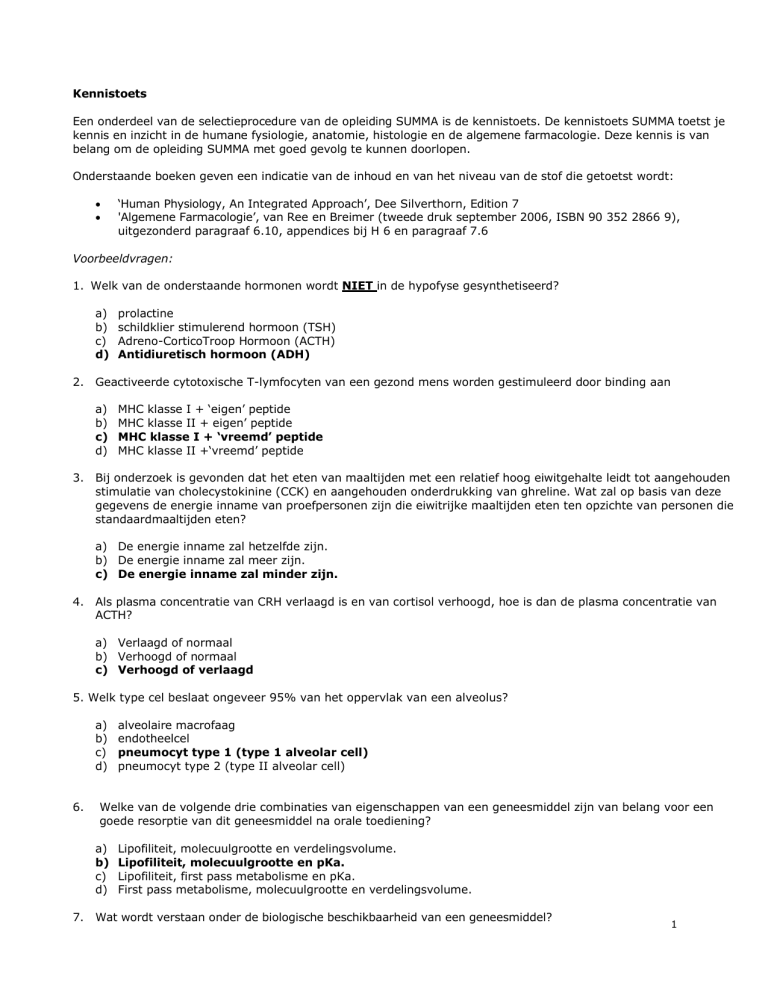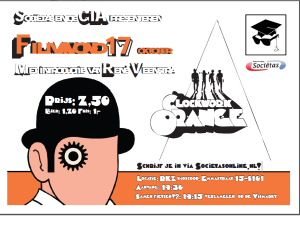
Kennistoets
Een onderdeel van de selectieprocedure van de opleiding SUMMA is de kennistoets. De kennistoets SUMMA toetst je
kennis en inzicht in de humane fysiologie, anatomie, histologie en de algemene farmacologie. Deze kennis is van
belang om de opleiding SUMMA met goed gevolg te kunnen doorlopen.
Onderstaande boeken geven een indicatie van de inhoud en van het niveau van de stof die getoetst wordt:
‘Human Physiology, An Integrated Approach’, Dee Silverthorn, Edition 7
'Algemene Farmacologie’, van Ree en Breimer (tweede druk september 2006, ISBN 90 352 2866 9),
uitgezonderd paragraaf 6.10, appendices bij H 6 en paragraaf 7.6
Voorbeeldvragen:
1. Welk van de onderstaande hormonen wordt NIET in de hypofyse gesynthetiseerd?
a)
b)
c)
d)
prolactine
schildklier stimulerend hormoon (TSH)
Adreno-CorticoTroop Hormoon (ACTH)
Antidiuretisch hormoon (ADH)
2. Geactiveerde cytotoxische T-lymfocyten van een gezond mens worden gestimuleerd door binding aan
a)
b)
c)
d)
MHC klasse I + ‘eigen’ peptide
MHC klasse II + eigen’ peptide
MHC klasse I + ‘vreemd’ peptide
MHC klasse II +‘vreemd’ peptide
3. Bij onderzoek is gevonden dat het eten van maaltijden met een relatief hoog eiwitgehalte leidt tot aangehouden
stimulatie van cholecystokinine (CCK) en aangehouden onderdrukking van ghreline. Wat zal op basis van deze
gegevens de energie inname van proefpersonen zijn die eiwitrijke maaltijden eten ten opzichte van personen die
standaardmaaltijden eten?
a) De energie inname zal hetzelfde zijn.
b) De energie inname zal meer zijn.
c) De energie inname zal minder zijn.
4. Als plasma concentratie van CRH verlaagd is en van cortisol verhoogd, hoe is dan de plasma concentratie van
ACTH?
a) Verlaagd of normaal
b) Verhoogd of normaal
c) Verhoogd of verlaagd
5. Welk type cel beslaat ongeveer 95% van het oppervlak van een alveolus?
a)
b)
c)
d)
6.
Welke van de volgende drie combinaties van eigenschappen van een geneesmiddel zijn van belang voor een
goede resorptie van dit geneesmiddel na orale toediening?
a)
b)
c)
d)
7.
alveolaire macrofaag
endotheelcel
pneumocyt type 1 (type 1 alveolar cell)
pneumocyt type 2 (type II alveolar cell)
Lipofiliteit, molecuulgrootte en verdelingsvolume.
Lipofiliteit, molecuulgrootte en pKa.
Lipofiliteit, first pass metabolisme en pKa.
First pass metabolisme, molecuulgrootte en verdelingsvolume.
Wat wordt verstaan onder de biologische beschikbaarheid van een geneesmiddel?
1
a) De fractie van de toegediende dosis die wordt geresorbeerd vanuit de darm in de systemische circulatie
(exclusief de poortader).
b) De fractie van de toegediende dosis die ongebonden in de systemische circulatie (exclusief de poortader)
komt.
c) De fractie van de toegediende dosis die onveranderd in de systemische circulatie (exclusief de
poortader) komt.
d) De fractie van de toegediende dosis die gebonden in de systemische circulatie (exclusief de poortader) komt.
Voorbeeld Engelstalige schrijfopdracht
On the $ 1000 Genome Future
James D. Watson was the co-discoverer of the DNA double helix structure (1953) and founding father of
the $ 3 billion / 13 year Human Genome Project, which completed the first human genome in 2003. James
Watson was also the first person to receive his own personal genome – all 3 billion base pairs of his DNA
sequenced. The cost was $ 1 million, and the process took two months. A copy of his full diploid genome,
recorded on two DVDs, was presented to the 79 year old Nobel laureate on May 31, 2007 in a ceremony
in Houston. This event marked what many scientists believe is the gateway to an impending era of
personalized genomic medicine. Only a few days later, the second personal genome was made available to
researchers: that of J. Craig Venter. His company, Celera Corporation, started a human genome project in
competition with Watson’s government project in 1998, and completed it successfully also in 2003.
Importantly, Watson said at the occasion that he will make his entire genome available for researchers to
study, with the single exception of his apolipoprotein E gene, the status of which he does not wish to know
because it predisposes a person towards Alzheimer’s disease. At the same time, he made public that his
DNA demonstrates a predisposition for cancer: he himself had skin cancer; his sister currently had breast
cancer.
Amy L. McGuire, a medical ethicist involved in the Watson sequencing project, commented that Watson
and Venter were following the medical tradition of making oneself the first subject of a new experiment
and would incur unknown risks: their genomes are likely to contain mutations that could lead to disease,
revealing unfavorable information about themselves and their relatives.
The National Institutes of Health in the USA predicted that technological advances could bring down the
cost for full personal genome sequencing from $ 1 million in 2007 to $ 1000 by the year 2014. If so, this
would bring into reach the sequencing of anyone’s genome at affordable cost and speed. It thus seems
that most of us not only will live to see full genome sequencing and testing become commonplace; we will
also soon be confronted individually and as a society with far-reaching and yet unforeseeable
consequences of these advances in medical technology.
-----------------------------------------------------------------------Read the above text carefully, and write a coherent essay (400-600 words) in which you perform the
following tasks:
Give your personal assessment of, and views on, the $1000 Genome Future in which you take into
consideration:
1. The possible implications for future medical research and practice.
2. The possible personal and societal implications of discoveries of genetic variations that contribute
to individual characteristics, such as intelligence, physical appearance, behavior, etc.
2










